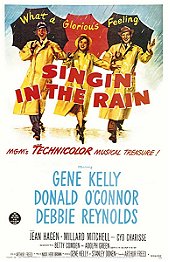Singin’ in the Rain plants its tongue in both of its cheeks at the same time, offering up a self-aware guffaw, and an eye-roll over how preposterous this whole fame thing is. Typically, Hollywood can’t help but indulge in some deeply self-critical appraisals in films about its own practices and history, but Singin’ in the Rain is a jubilant blast of musical comedy.
Telling the story of the fraught transition between the silent era and the talkies, Singin’ in the Rain plays like A Star Is Born for laughs and a happily-ever-after. Composed as a love letter to not only the industry, but to MGM’s Arthur Freed, the super-producer of the most beloved and well-known musicals of the 30s through 50s. A jukebox musical primarily comprised of various songs written by Freed and Nacio Herb Brown, Singin’ in the Rain is the high-water mark for movie musicals.
Effervescent and easy to embrace, Singin’ in the Rain is a colorful blast of smart, sharp satire. Gene Kelly and Jean Hagen capture some of the more overripe silent film mugging. Kelly in particular rides upon a Douglas Fairbanks-like swashbuckler vibe in these sequences, and his ridiculous mugging never fails to get a laugh out of me. And Hagen’s Lina Lamont is one of the great comedic creations, a completely ditzy, utterly glamorous movie star who opens her mouth to bellow like a gum-snapping gangster’s moll.
And that voice is the main crux of the plot, when the latest vehicle between the two silent stars is reconceived as a talking picture, the production encounters a great deal of trouble in dealing with her screeching. Of course, Singin’ in the Rain also has some fun with popular Hollywood myths about the problems encountered with the sound transition – picking up a heartbeat, the oppressive clacking of a pearl necklace, and the sound falling out of synch resulting in the actors voices switching.
To cover up Lamont’s unique vocal intonations, they decide to dub her voice with that a young starlet (Debbie Reynolds). Reynolds was herself a young starlet at the time, a bit-player being moved to the major leagues, and she’s absolutely dynamite. Perky and energetic, Reynolds is the sneak-attack of the four main players. Hagen was a veteran character actress by this point, and deservedly nabbed an Oscar nomination for her work here, and Donald O’Connor was known as a song-and-dance man, one of the better supporting players who made his rounds around the major studios. Kelly was the big star and main attraction, but it is Reynolds who is the heart and soul of Singin’ in the Rain. She is the young ingénue who must believably sell us on the drama and romance giving a more robust flavor to the comedy.
What gets lost in declaring Singin’ in the Rain the greatest movie musical of all-time is how wonderfully it works as a straight comedy. “Make ‘Em Laugh” isn’t just a memorable song here, but an overriding ethos. The film opens with a big premiere party, packed with jokes for the film buff including Rita Moreno’s cameo as an obvious Clara Bow proxy, or later on when the major producer claims he can’t visualize a big production number that we’ve just witnessed. Or the way Kelly’s Don Lockwood gives us a fabricated back-story, the kind that the celebrity gossip rags would run back in those days, while we witness the true events that led to his stardom and pairing with Lamont. These moments of self-aware comedy are quick witted and memorable.
This isn’t to take away from the wall-to-wall show-stoppers that make-up Singin’ in the Rain. One of my favorite big-screen experiences was seeing this at a revival house during which the audience broke out into rapturous applause and cheering after several of the musical numbers. “Make ‘Em Laugh” is filled with O’Connor’s wild gesticulations and muggings, and it’s a great synthesis of dance, song, and comedy. “Moses Supposes” is a great bit of tap-dancing anarchy between Kelly and O’Connor as they tear apart an elocution teacher’s office space. “Good Morning” is a joyful routine between Kelly, O’Connor, and Reynolds. “Singin’ in the Rain” is the iconic piece, and with good reason. Kelly’s choreography throughout is varied, athletic, graceful, and specific to the moment. His genius here is in knowing when to keep it simple, that sometimes splashing around in puddles is the purest way to express joy and elation in a new love. Never before have an umbrella and lamppost seemed so romantic.
It wouldn’t be a Gene Kelly film without an extended ballet dream sequence, and while the one here can’t quite compete with the prior year’s An American in Paris, it’s still a damn fine number. Cyd Charisse is an erotic vamp complete with a Louise Brooks bob, and Kelly’s dumbstruck expression over her legs is the only logical response. It’s an explosion of neon lights, colorful geometric shapes, and large masses of dancers moving as a utilitarian group.
Widely regarded as the greatest film musical ever produced, and with damn good reason as it works on every conceivable level, Singin’ in the Rain is one of our cinematic treasures. A smart aleck love letter and pop art cinematic history lesson telling us how the movies learned to sing, dance, and talk. This isn’t just a great song-and-dance show, but a glorious film that earns its spot among the canonized greats for sheer joie de vivre and comedic gusto.
 Login
Login